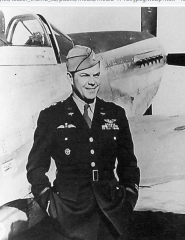William Dunn

William Dunn
WILLIAM
DUNN
SOLDIER DETAILS
BIOGRAPHY
William "Bill" "Poppy" Dunn was born Nov. 16, 1916 in Minneapolis, Minnesota. After receiving an airplane ride at 12 years of age, Bill Dunn knew he wanted to be a pilot. By 15, he had over 100 hours of flying time. Young Dunn learned to break wild horses in North Dakota and went on to become a cowboy on the rodeo circuit. In 1934 a crafty recruiting sergeant convinced Dunn his flying experience qualified him to be an Army aviation cadet. Instead he spent three years in the infantry and was discharged in 1937. Dunn became a commercial artist until war broke out in Europe in 1939. Dunn joined the Canadian Army with the assurance he could quickly transfer to the Royal Canadian Air Force. Instead his air defense unit went to England. During the Battle of Britain in August 1940, Dunn shot down two German Stuka dive-bombers with a Lewis machine gun. Finally, six weeks later, his flying experience earned him a spot as a pilot officer in the Royal Air Force. Following his training, Dunn was assigned to RAF 71 Eagle Squadron, made up of American volunteer pilots. On July 2, 1941, flying the Spitfire, Dunn became the first Eagle Squadron pilot to shoot down a German airplane. The next month, on Aug. 27, 1941, Dunn started his mission with four German planes to his credit. Dunn got on the tail of a German Me 109 and opened fire. “I see the grayish-white tracer streaks from my guns converge on the Messerschmitt’s tail section. The elevators and rudder disintegrate under the impact of the explosive DeWild bullets. Pieces fly off the enemy’s fuselage,” Dunn said. “The range is now down to 50 yards. Black liquid-engine oil spatters my windscreen and a dense, brownish colored smoke is flung back at me. My enemy is finished. Splash one, but good! I’ve got my fifth victory!” Dunn shoots down another German plane, but then is attacked by four Me 109s. He is badly wounded and barely makes it back to base. The front of his right foot has been blown off by a 20-mm cannon shell. In addition two machine gun bullets went through his right calf and his skull was grazed by a machine gun bullet. He was sent back to the states to recover and his time in the Eagle Squadrons came to an end. Despite his injuries Dunn returned to Europe flying P-47 Thunderbolts in the 406th Fighter Squadron. He shot down more German planes and was again wounded. A bomb from the P-47 taking off before him dropped off and exploded under his plane. He still completed his tour of duty. Having completed two tours in Europe, one with the RAF and one with the U.S. Army Air Forces, Dunn volunteered for service in the Far East in the China-Burma-India theater. He flew P-51 Mustangs and rose to the rank of Lt. Col. Following the Japanese surrender he served as an advisor to the Nationalist Chinese Air Force. His willingness to serve anytime, anywhere in WWII was a testimony to his dedication and patriotism. After WWII, Dunn remained in the Air Force and retired in 1968. He served a total of 38 years in the Royal Air Force, the U.S. Army Air Forces and the U.S. Air Force. In addition to WWII, he fought in the Korean War and the Vietnam War. He flew a total of 378 combat missions. In retirement Dunn achieved success as a painter and author. He passed away in Colorado Springs, Colorado in 1995. Courtesy of Seymour Johnson Airforce Base.
 Eisenhower Foundation
Eisenhower Foundation
